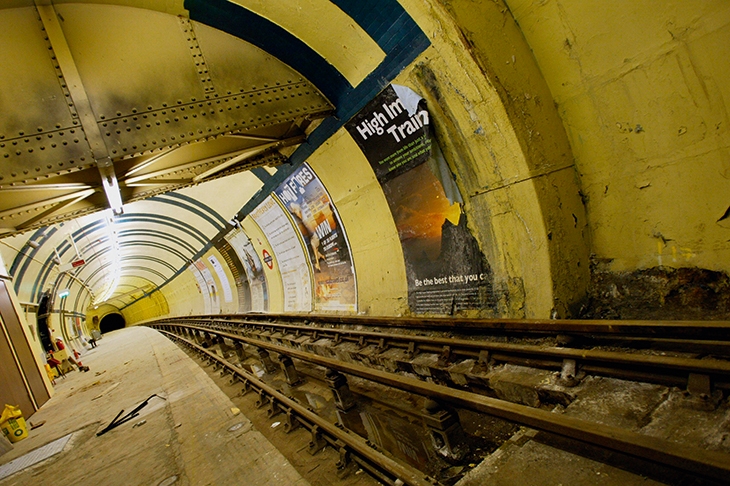If you’ve ever travelled on London’s Piccadilly Line, you may have noticed that on the stretch between Green Park and South Kensington, the north-facing tunnel twice changes to a peculiar dark grey rather than the familiar charcoal black. I always used to look out for these grey bricks when I took the Tube back home to Hammersmith. This is because I was obsessed with disused, or ‘ghost’ stations, and on this stretch were two of the most distinguished: Down Street and Brompton Road, both of which were closed in the 1930s.
Down Street is of particular interest, having served in the following decade as a bunker for Winston Churchill during the war. As a station, it had hardly been used after opening in 1907. It was too close to Green Park (then called Dover Street) and Hyde Park, and situated in an area with few residents. Trains often didn’t even bother to stop there, and it shut its doors to passengers for good in 1932.
Dozens of London Underground stations have been closed over the years owing to infrequent use or rationalisation, but their remains also earn them the moniker of ‘ghost station’. One is King William Street, near present-day Monument Station, which was the original terminus of the City & South London Railway (now the southern leg of the Northern Line). When it opened in 1890 it was the first deep-level underground railway in the capital, but its life was cut short in 1900 when the line was redirected to Bank. Although the building was demolished, the platforms remain, and a plaque commemorating its short life can be seen today on Monument Street.
Another is Marlborough Road on the Metropolitan Line. It had a meagre passenger uptake except during the cricket season, owing to its proximity to Lord’s. Its death-knell came in 1939, following the opening of nearby St John’s Wood. The building remains and until 2009 housed a Chinese restaurant. It now contains an electrical substation supporting the Metropolitan Line.
The king of all London’s ghost stations is the most recent: Aldwych, once known as Strand. Opened in 1907, it was the terminus and only station on that curious leg of the Piccadilly Line shuttling mostly theatre-goers to and from Holborn. Over the years the station never saw many passengers, and was subject to numerous threats of closure before the end finally came in September 1994, when it was decided that it didn’t warrant the cost of replacing the lifts.
The station and street building remained, with a facade of its original name installed. Because its second platform had been closed in 1917, it came to be used by film directors seeking to recreate generic scenes of the Underground. It made its cinematic debut in The Gentle Gunman (1952), and later featured in The Krays (1990) and Patriot Games (1992). Aldwych has since starred in V for Vendetta, 28 Weeks Later and the BBC drama Sherlock.
When I used to take the no. 15 bus from the Strand to Tower Hill, the sight of the empty Strand would induce reveries of Harry Potter-esque ghost trains, or passengers now dead and gone. So would the building at Tower Hill housing a Pizza Express, because until 1967 that building was Mark Street Underground Station.






Comments